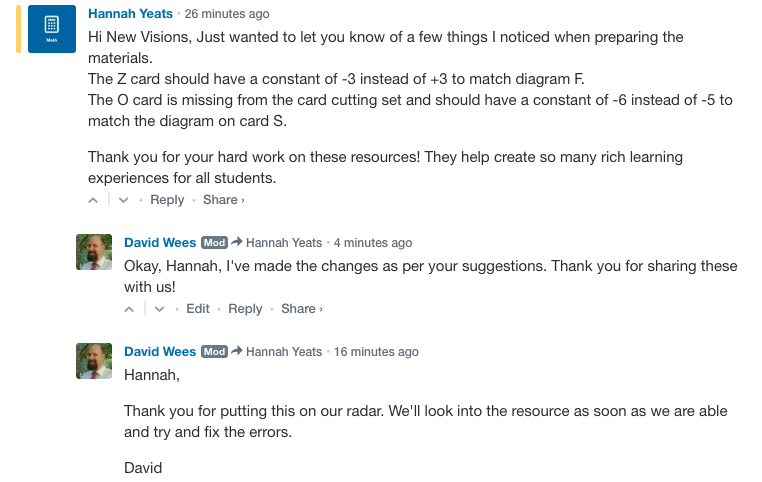As some of you probably know, I’m one of the lead designers on an open source math curriculum. Today I had an interaction that reminded me of a key benefit of open source curriculum.

In a traditional curriculum model distributed either on paper or via PDF, Hannah would have to either print and then painstakingly correct the errors above by pasting over them or use some likely-painful-to-use PDF editing software to fix these errors.
We distribute our open source curriculum via Google Docs and as a result Hannah can just make a copy of the document, make the edits she wants, and then print the resources for her students. Hannah is also legally able to do this because our curriculum is licensed specifically for adaptations.

Since each resource we create has its own page on our website (the resource Hannah describes is here), Hannah was able to comment on a specific document and I was able to respond to her transparently.
There are drawbacks of using Google Docs. For example, it is not currently possible with our curriculum to print out the entire set of student handouts. This is a fairly frequent request we get from teachers but we don’t know yet if the loss of editability is worth the increased ease of printing resources.
It would be helpful for me to know what other pain-points exist for teachers when adapting and modifying curriculum for their own classroom use, especially given that a high percentage of teachers make adaptations to curriculum they are given. If you were in charge of how someone shared curriculum, what would make it as easy as possible for you to make thoughtful changes to that curriculum?
Susan Jones says:
It depends 🙂
It would be neat if there were professional development time to share ideas and adaptations, especially if they can work in a little “open pedagogy” and get students involved in creating things. One of my faculty friends creates word problems with a local angle because the students said they thought that would be fun… she hasn’t gotten to where they make up more problems but who knows 🙂
January 8, 2019 — 8:13 pm
David Wees says:
I work in time in nearly every workshop I run around our curriculum for teachers who have been using it for a bit to share some of the changes and/or adaptations they’ve made. It helps with comfort I think, and with teachers learning over time what kinds of changes end up being productive and what kinds of changes end up not being productive.
January 8, 2019 — 11:59 pm
Michael Pershan says:
I adapt stuff all the time. The thing that seems silly but actually makes a HUGE difference is the ease of taking images and diagrams from the curriculum without having to do more serious editing. If a curriculum wanted to be maximally adaptable by me, it would be full of good old html text and full of images that I can right click, copy and paste into a new doc.
January 8, 2019 — 11:51 pm
David Wees says:
That seems like it would be easy to test. How do you find Google Docs for ease of image/diagram copying? One thing I intend to do is create a gallery of all of the Geogebra files we used to create our graphs & diagrams. Would that also be useful to you?
January 8, 2019 — 11:55 pm
Michael Pershan says:
Google docs is great for text, not great for images. The easiest thing is actually IM’s pages, because when I need to modify a task I can usually copy the text and the image and then just tinker in a new doc. When I’m working from Google Docs, I need to screenshot the image and reuse it…honestly, not that big a deal. Also I can make a copy of the doc and then just edit it directly. I don’t know if having a separate collection of images would be super helpful, just because that would be some other thing to keep track of and search through.
I will say that google docs aren’t a ton of fun for browsing and quickly scanning and understanding the approach of a unit, but it’s also not that big a deal.
January 9, 2019 — 1:41 am